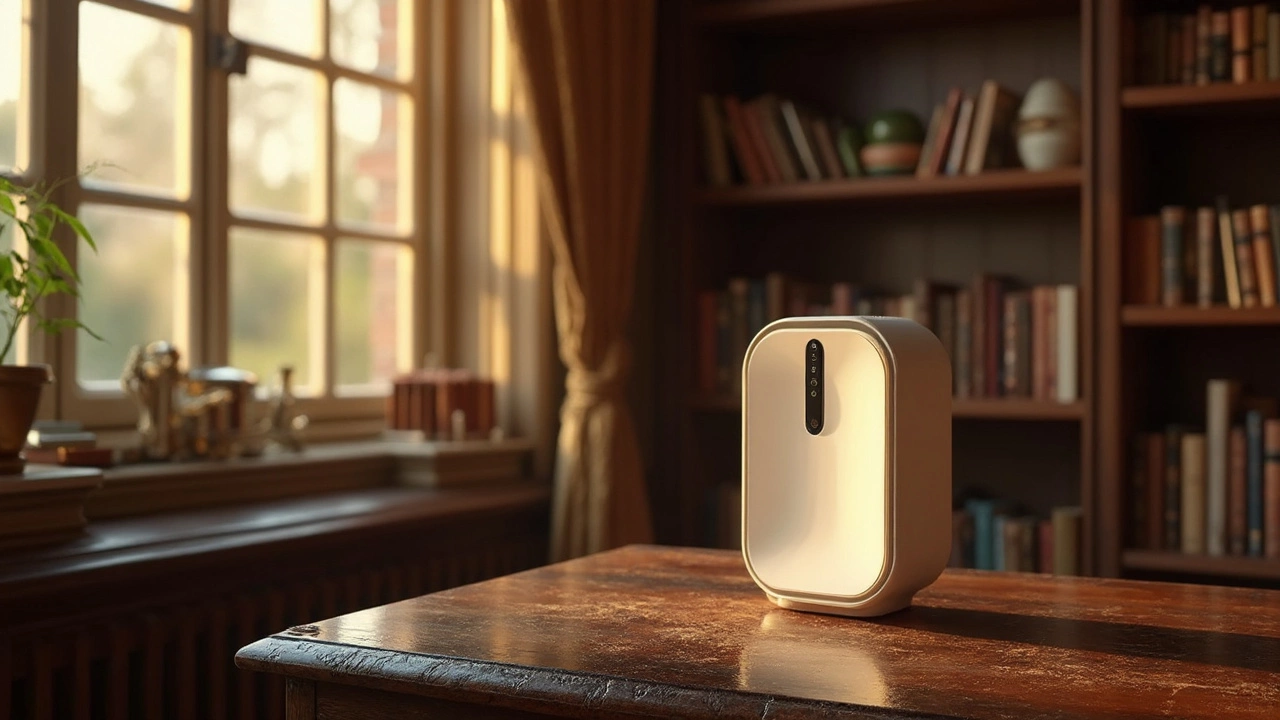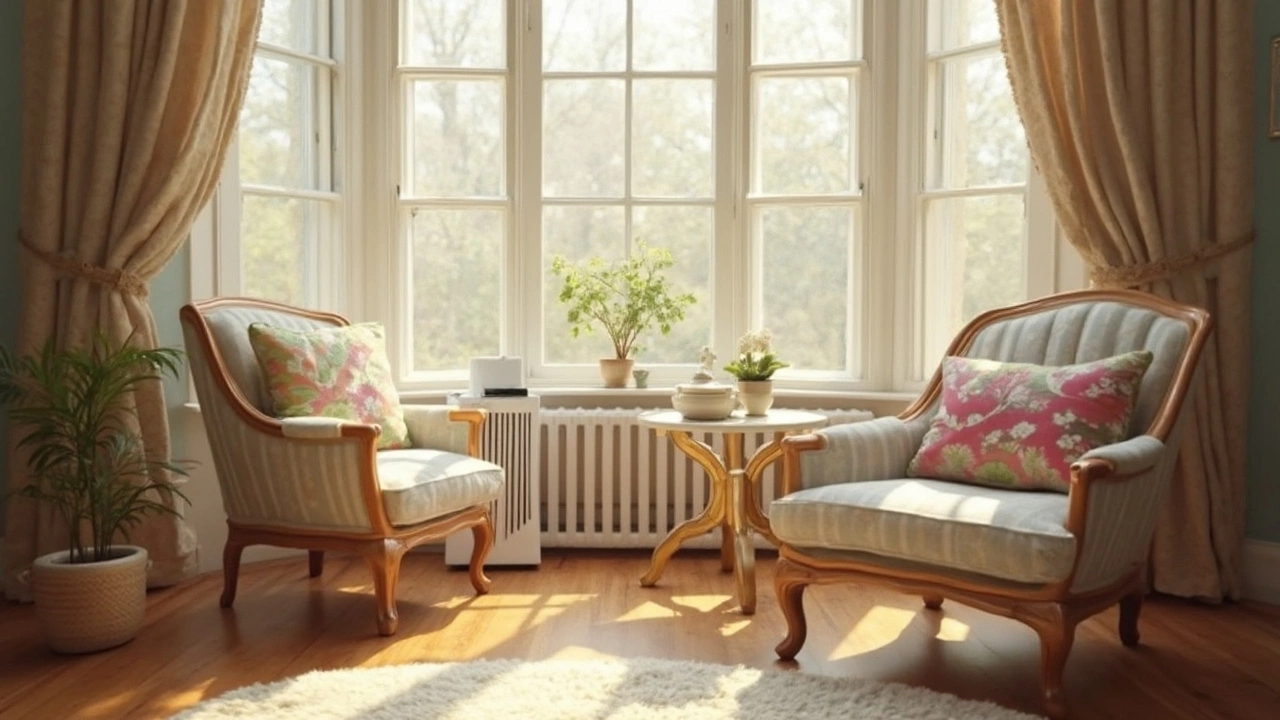Figuring out where to put your air purifier might not seem like rocket science, but it sure makes a difference in tackling dust. Most folks mistakenly shove their purifiers wherever they assume it fits, without considering if it's actually going to work its magic effectively there. Not so ideal, right? It's all about finding that sweet spot where dust has nowhere to hide.
Start by checking how air sweeps through your crib—yeah, airflow matters! Big rooms with lots of ins and outs can mean your purifier works overtime if it's stuck in the corner. Placing it near open windows or doors can waste half its effort there. Ever tripped over an appliance thinking it was part of the furniture? Us too. Resist jamming the purifier behind the couch or any hefty furniture because, spoiler alert, air won't flow through solid wood or plush fabric.
- Understanding Airflow and Room Dynamics
- High Traffic Areas at Home
- Close to Dust Sources
- Avoiding Common Obstacles
- The Impact of Air Purifier Size
- Regular Maintenance and Filter Replacement
Understanding Airflow and Room Dynamics
Ever watched how smoke moves through a room? That's pretty much how air—and with it, dust—moves around your space. Knowing this can be your secret weapon in placing your air purifier for the best dust control. First thing's first, you need to recognize the pathways of air in your house. Air flows from areas of high pressure to low pressure, often getting redirected by walls, furniture, and sometimes even the heat from your TV.
Your room’s layout is a biggie. Rooms with more windows and doors have more entry points for airflow, meaning that your air quality can vary throughout the space. Pay mind to cross-ventilation, that natural wind that sweeps through when you open windows at opposite ends of the room. It can help an air purifier work more efficiently if placed correctly.
Spotting the Right Placement
Start by identifying 'intake' and 'outlet' pathways. Say you have a fan circulating air in the room, the air purifier should be positioned such that it captures the incoming dust before it swirls all over again. In rooms with central air conditioning, locate the vents since they tend to circulate dust more significantly around their areas.
Don't Block the Flow
Sounds obvious, but you'd be surprised how many air purifiers end up stuck behind sofas and bookshelves, hindering their efficiency. Leave at least a couple of feet of clearance on all sides for optimal air capture. It's all about letting the purifier do what it does best—filter that dust out without any blockages.
| Room Type | Optimal Placement |
|---|---|
| Living Room | Centrally but elevated (like on a small table) |
| Bedroom | Near air vents or open windows |
| Office | Away from electronics and in high traffic areas |
With this knowledge, you can place your device like a pro and breathe in that sweet, dust-free air. So, ready to set it up for success?
High Traffic Areas at Home
When you're thinking about where to stick that air purifier to keep dust at bay, high traffic areas are a smart bet. Why? Because these are the spots where dust seems to party the hardest, thanks to all the commotion of daily life. Imagine the floors and surfaces around here as a kind of dust magnet, drawing in everything from dander to dirt.
Let's get specific. The living room, especially if it's open-plan, is usually prime real estate for gathering dust. Consider placing your purifier somewhere central like on a side table or a shelf away from the TV and big furniture. Make sure it isn't blocked by any décor items. Remember, if there's dust swirling around every time someone walks through, that's a sign your purifier should be right there in the thick of it.
The entryway or hallway is another hotbed for dust build-up, often carrying dust in from outside - especially if you have pets that love rolling in the dirt. Placing your purifier in these areas means it's ready to capture dust before it spreads into other parts of your home.
It might surprise you, but the kitchen can also see a lot of dust action, especially if it's part of a larger open living space. The movement from cooking and dining generates airborne particles, so consider setting your purifier nearby but away from moisture-heavy areas like the sink.
Positioning air purifiers strategically in these high-traffic spots can significantly boost your home's air quality. For an even spread of cleaner air, try to place the purifier so it's got a wide reach, maybe altering its position periodically to cover the whole room effectively.
A simple rule of thumb for dust control: if you and the family spend tons of time there, the purifier should be there too.
Close to Dust Sources
Placing your air purifier near known sources of dust makes a world of difference. Most dust in your home comes from everyday activities, so think about spots that get the dustiest.
Got a furry friend snuggled up at home? Pet hair and dander are major dust contributors. Keep your purifier in your pet's favorite hangout, and see if that doesn't help the air look less like a shedding competition.
Kitchens and dining areas, for one, can be culprits too. As we cook and chow down, tiny particles float through the air. Setting up your purifier nearby keeps the aftermath in check.
According to James Applied Sciences, "Positioning an air purifier next to dust hotspots—like pet beds or high-footfall areas—can significantly enhance air quality within a room."
If you’ve got a home office setup, your workspace might be another place to consider. Think about how much dust builds up on your computer and gadgets. Electronics—they don’t just attract us but also dust! Sliding your purifier nearby can keep that under control.
Key Dust Magnet Areas
- Pet beds and play areas
- Near doors and windows—there's always a bit of outdoor dust sneaking in.
- Home office desks and electronics
- Kitchens, especially if your vent isn’t top-notch
In all, pinpointing these dust control spots helps your purifier work smarter, not harder. Keep your purifier's filters in check too, ensuring that they're clean so they can handle the dust effectively.

Avoiding Common Obstacles
Putting your air purifier in the wrong spot can really mess with its ability to control dust. You'd be shocked how many people wedge theirs between TV stands or tuck them away behind furniture because, well, it's convenient. But let me tell you, that's a rookie move.
First, think about walls and furniture. Yeah, they might look good hiding stuff, but they also block air circulation. Your purifier needs space to breathe—literally. The basic rule? Give it a good two to three feet of clearance on all sides. Think of it like a buffer zone where air can flow smoothly.
Dealing with Electronics
Now, about electronics. Laptops, TVs, games consoles—they chuck out heat and disrupt air currents. Avoid placing your air purifier right next to them. The heat can mess with filtration efficiency, and who wants that?
Windows and Doors
Then there's the whole open windows and doors situation. Let's say you've placed your purifier close to an open window; that's like forcing it to compete with outside air currents. Makes no sense, right? Keep it a safe distance from any drafts to let it focus on your indoor air.
Keeping It Clean
Don't forget to keep the purifier's intake and outtake grills clear of dust and grime. A blocked purifier can't perform well, and you're back to square one with dusty air. Regular wipes with a damp cloth keep things in tip-top shape.
The Impact of Air Purifier Size
Okay, so size really does matter, especially when we're talking about picking an air purifier. It's not just about snagging the biggest or the most stylish one. Nope, it's about matching the purifier's muscle to the room's demands.
First off, check out the CADR—Clean Air Delivery Rate. This is your magic number for figuring out how quickly the purifier can zap dust in a specific room size. Say you're putting it in a living room that's about 300 square feet. You'll want a purifier with a CADR that matches or beats that square footage.
Air purifiers also come with different ACH—Air Changes per Hour. This tells you how often they'll filter the entire room's air in an hour. More ACH means cleaner air more frequently. Generally, look for an ACH of at least 5 for effective dust control.
Here's a quick look at different needs:
| Room Size (sq. ft.) | Recommended CADR (cfm) | Recommended ACH |
|---|---|---|
| 100 - 200 | 65 - 130 | 5 |
| 200 - 400 | 130 - 260 | 5 |
| 400 and above | 260+ | 5+ |
Remember, the ambiance matters too. Overpower your cozy bedroom with a unit meant for a massive basement, and you're just wasting juice. Likewise, a dinky purifier in your giant living room is like an ant trying to move a mountain.
So, before you click 'buy,' measure your space, know your numbers, and choose a purifier that's just right for those needs. It's all about more than just picking something off the shelf—it's matching size to performance for truly fresh air.
Regular Maintenance and Filter Replacement
Keeping up with your air purifier isn't just a suggestion—it's a necessity if you want it to slay dust efficiently. Those filters are working hard for you, trapping all kinds of gunk, so you don't breathe it in. So, giving them a hand is only fair.
Stay on Top of Dust Buildup
Check your purifier's pre-filter at least once a month. Dust loves to settle here first. If it looks like it's wearing a new wool coat, it's time for a clean. A quick vacuum or rinse (if the manual says it's safe) will do wonders in making sure your purifier doesn't work overtime.
Filter Replacement 101
- HEPA filters need some love too—switch them out every 12 to 18 months depending on your usage. If you run the purifier non-stop, think about a yearly change.
- Activated carbon filters are the unsung heroes for smells—they can get clogged faster, so aim for replacement every 6 months or less.
Still not sure when to replace them? Some air purifiers have handy lights or alerts to remind you. If not, keep a check on performance; if the dust isn't getting caught and the air smells stale, it might be time.
A Handy Table on Filter Lifespan
| Filter Type | Usual Replacement Time |
|---|---|
| HEPA Filter | 12 to 18 months |
| Activated Carbon Filter | Every 6 months |
| Pre-Filter | Monthly Cleaning |
And hey, don't forget about the fans and vents inside the purifier. Dust can sneak in here too, making everything less efficient. A soft brush will help knock the dirt loose. Trust me, a clean machine is a happy machine.

